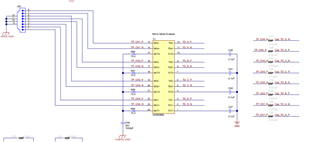Other Parts Discussed in Thread: DP83869
Tool/software:
Hi Team,
We are considering configuring PHY Capacitive Coupling (Transformerless Operation) for the DP83869HM.
Please tell us the following points about PHY Capacitive Coupling (Transformerless Operation) for the DP83869HM.
Also, we checked the following thread as a method of capacitive coupling for DP83869HM.
<e2e>
e2e.ti.com/.../faq-ti-ethernet-phy-capacitive-coupling-transformerless-operation
In the document AN-1519 DP83848 PHYTER Transformerless Ethernet Operation (SNLA088A) in the main text, the recommended capacitor value was listed in "5. Capacitor selection".
◇Excerpt from SNLA088A
Please let me know the following points regarding the above information:
[Question 1]
In the above datasheet, AN-1519 DP83848 PHYTER Transformerless Ethernet Operation (SNLA088A), "5. Capacitor selection" states that the recommended value of the capacitive coupling capacitor is 33nF.
Is the recommended value for the capacitive coupling capacitor the same for 10/100/1000BASE circuit configurations?
[Question 2]
The datasheet above, AN-1519 DP83848 PHYTER Transformerless Ethernet Operation (SNLA088A), states that the recommended capacitor value is 33nF, with a minimum value of 30.42nF (@2MHz).
Therefore, I believe the recommended product would be 33nF±1% or 33nF±5%.
Is the above understanding correct?
[Question 3]
We checked the DP83869 EVM circuit diagram (snlr042) and BOMLIST (snlr043).
However, in the DP83869 EVM circuit diagram (snlr042), the capacitive coupling capacitor is 0.033uF±10% and has a voltage resistance of 10V.
When checking the capacitor's tolerance, it is a ±10% product, so in the worst case, it fluctuates from 29.7 to 36.3nF, so we believe that there are cases where the minimum value of 30.42nF is not met.
Also, we believe that a capacitor with a voltage resistance of 1500Vdc or more is necessary to meet the AC and DC isolation requirements of IEEE802.3.
Regarding the parts used in the DP83869 EVM, are they recommended capacitor parts?
◇Excerpt from the DP83869 EVM circuit diagram (snlr042)

[Question 4]
We are considering operating our circuit at 10/100/1000BASE.
However, the TI application note AN-1519 DP83848 PHYTER Transformerless Ethernet Operation (SNLA088A) only describes a circuit for capacitive coupling at 10/100BASE.
Is the DP83869HM a part that supports all speeds for 10/100/1000BASE capacitive coupling configurations?
Best Regards,



